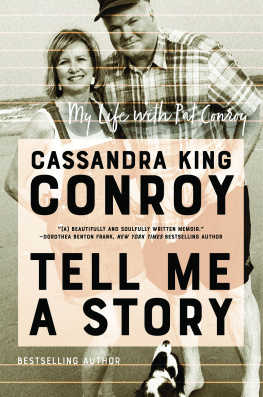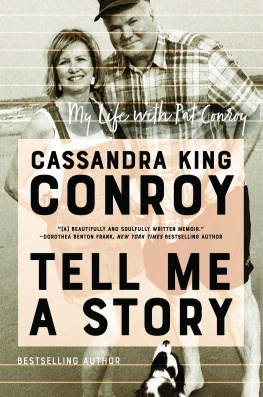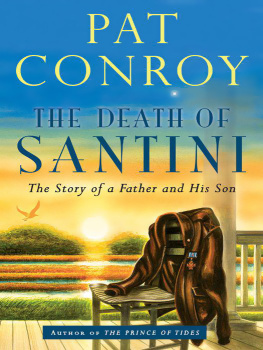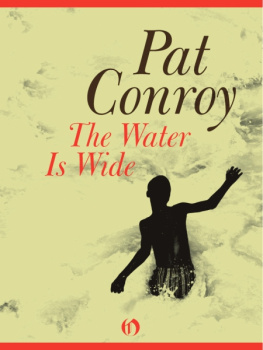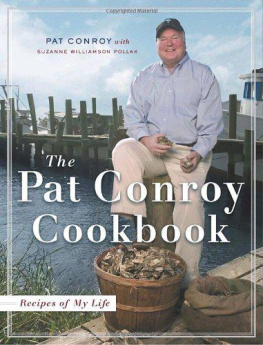CONVERSATIONS WITH THE CONROYS

The Conroy family at the SCETV-Radio studios in Columbia following their February 28, 2014, interview with Walter Edgar: Jim Conroy, Tim Conroy, Kathy Harvey, Pat Conroy, and Mike Conroy. Photograph by Fran Johnson, courtesy of SCETV
Conversations with
the CONROYS
Interviews with Pat Conroy
and His Family
EDITED WITH AN
INTRODUCTION BY Walter Edgar
AFTERWORD BY Nikky Finney

2015 University of South Carolina
Published by the University of South Carolina Press
Columbia, South Carolina 29208
www.sc.edu/uscpress
24 23 22 21 20 19 18 17 16 15
10 9 8 7 6 5 4 3 2 1
Library of Congress Cataloging-in-Publication Data can be found at http://catalog.loc.gov/
ISBN: 978-1-61117-630-8 (cloth)
ISBN: 978-1-61117-631-5 (paperback)
ISBN: 978-1-61117-632-2 (ebook)
Unless otherwise noted, all images in this book appear courtesy of the Pat Conroy Archive, Irvin Department of Rare Books and Special Collections, University of South Carolina Libraries.
Front Cover Illustrations: (top) illustration by Sarah Petrulis; (bottom) One Book, One Columbia keynote conversation between Walter Edgar and Pat Conroy, courtesy of Richland Library.
CONTENTS
Walter Edgar
Interview by Walter Edgar
Interview by Walter Edgar
Interview by Ada Rogers
Interview by Catherine Seltzer
Interview by Katherine Clark
Introduction
HOME AT LAST
The human mind is a fearful instrument of adaptation, and in nothing is this more clearly shown than in its mysterious powers of resilience, self-protection, and self-healing. Unless an event completely shatters the order of ones life, the mind, if it has youth and health and time enough, accepts the inevitable and gets itself ready for the next happening like a grimly dutiful American tourist who, or arriving at a new town, looks around him, takes his bearings, and says, Well, where do I go from here?
Thomas Wolfe, You Cant Go Home Again
For more than forty years I have plied my trade as historian in generaland historian of South Carolina specifically. While some in my profession have spurned local history as too provincial for their self-proclaimed cosmopolitanism, there are those of us who understand what John Adams meant when he said that to understand the American Revolution and American history, one needed to look first at local institutions. And, although the second president did not specifically say so, he implied that local history in context could help explain a larger story. That is the manner in which I approached writing this introduction to this collection of interviews with Pat Conroy and four of his siblings.
Each of these interviews needs to be looked at separatelyand then with all the others as a whole. For each one in sequence reveals a bit more about Pat Conroy, his siblings, and their relationships to their parents, Frances Peggy Peek and Col. Donald Conroy, aka the Great Santini. The conversations also let us follow the collective Conroy journeys of discovery to some place that they could at last consider home.
I first met Pat Conroy not in person, but through the observation of others. The first time I ever set eyes on Pat was in 1965, when my Davidson Wildcats were in Charleston to play the Citadel. The Wildcats were fantastic that year and trounced the Bulldogs 10081. After the game, I saw one of the Citadel guards run over and speak to Davidsons All-American Fred Hetzel: just a few words and then a handshake. Fast forward a decade or so. Gene Brooker, one of my friends and a classmate of Pats, was stricken with Guillain-Barr syndrome. Gene was hospitalized for months, and during that time Pat visited on numerous occasions to sit by his bedside for hours on end. At this point in his life, Pat Conroy had already hit the big time. This would have been a PR flacks dream: Noted writer flies to the bedside of stricken classmate with appropriate saccharine photographs. It didnt happen. I learned about these visits not from Pat, but from Genes sister-in-law from Mobile. She and I had grown up together, and if there ever were a cynic, Prather Pipes Brooker was one. She called me to tell me about what Pat had been doing for Gene. In part because she said some in the media were beating up on Pat for being brash and insensitive about the feelings of others. And she wanted me to set the record straight in South Carolina about what a truly gentle man Pat Conroy was.
Over the years that followed, Pats and my paths crossed at various meetings, but it was not until about twenty-five years ago that I had the pleasure of getting to know and appreciate the gentle man my friend had described. Since then, we have had numerous public and private conversations. Pats brother Tim arranged one of the public conversationsa benefit for the South Carolina Autism Society held at the South Carolina State Museum. Afterward Pat signed books for hours. And, as is his custom, he never just autographs a book. He has a conversation with every person in line. At our One Book, One Columbia conversation in front of a crowd of nearly two thousand, a transcript of which is included in this book, Pat signed books and spoke with fans until 1:00 the next morning. This was Pat the extrovert and Pat the gentle man having a personal word with everyone who placed a book in front of him because he never forgets that readers and not critics make the lasting careers of writers. A Pat Conroy signing is always a master class in reader appreciation, and any young writer with ambitions for her or his future should pay close attention to how Conroy treats his audience.
Thus the context for my writing this introduction is based on my having read every book Pat Conroy has written, attended more public readings and presentations than I can remember, and on getting to know the private man. I had known the Conroy siblings other than Tim only through Pat.
In the conversations transcribed in this book, I hope that the reader will see and appreciate the private Pat Conroy. Most folks know the larger-than-life public Pat, always generous with his time and his words, but the private Pat is someone every bit as special.
Since 2000 I have participated in hundreds of radio interviews and conversations. It is not easy to translate the emotion and body language that accompany a persons comments. For that reason I generally insist that guests on my program come to the SCETV-Radio studio, so that I can read their faces and their body language and not just listen to their words. Tone of voice can mask feelings, but clenched fists, crossed arms, rolling eyes, grins, grimaces, and tears cannot.
When USC Press director Jonathan Haupt and I broached the subject of a Conroy family interview with Pat, he wasnt sure that Tim, Kathy, Mike, or Jim would participate. And, if all of them showed up, he was unsure of what would occur. After all, it would be the first time that the five siblings were willing to share with a nonfamily member their reactions to growing up with the Great Santini. While there was banter and joshing, there was a palpable tension in the studio on February 28, 2014. This was not a conversation that was easy for any of them. But in that studio, it was the gentle Pat who was there to support his family as equal parts kind, thoughtful older brother and sage tribal elder. That same Pat was on stage for the conversation held several months later at the South Carolina Book Festival in front of hundreds and again in a more intimate conversation with two of his brothers in Charleston following his induction into the Citadel Athletics Hall of Fame.
Next page



